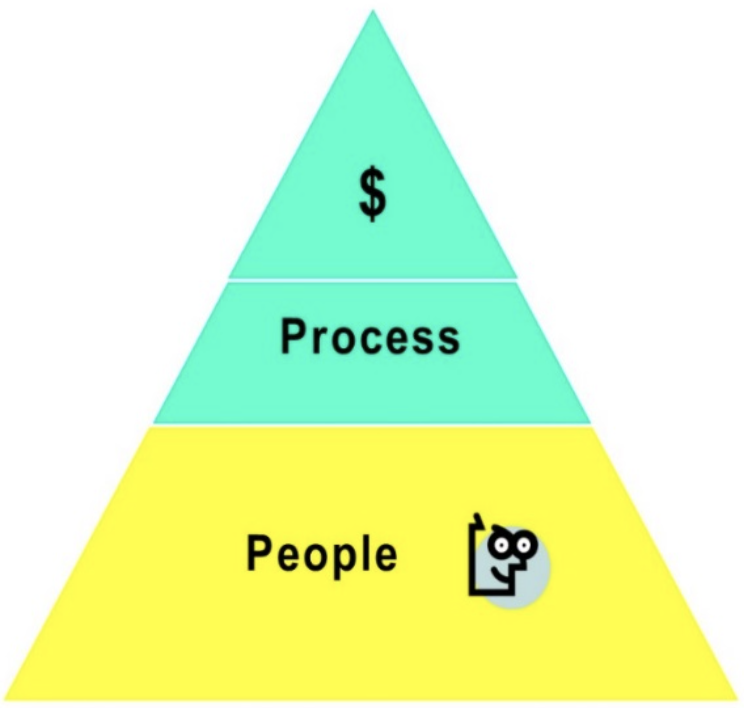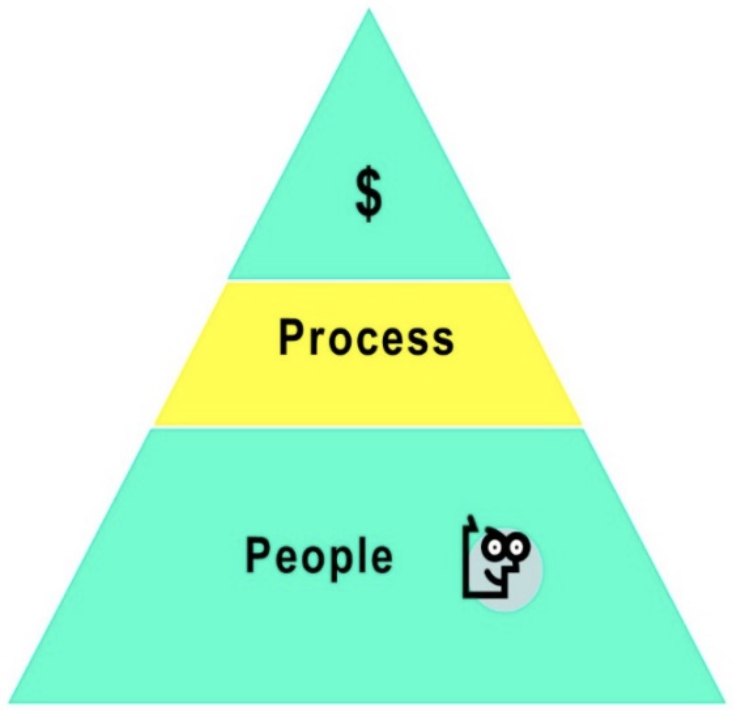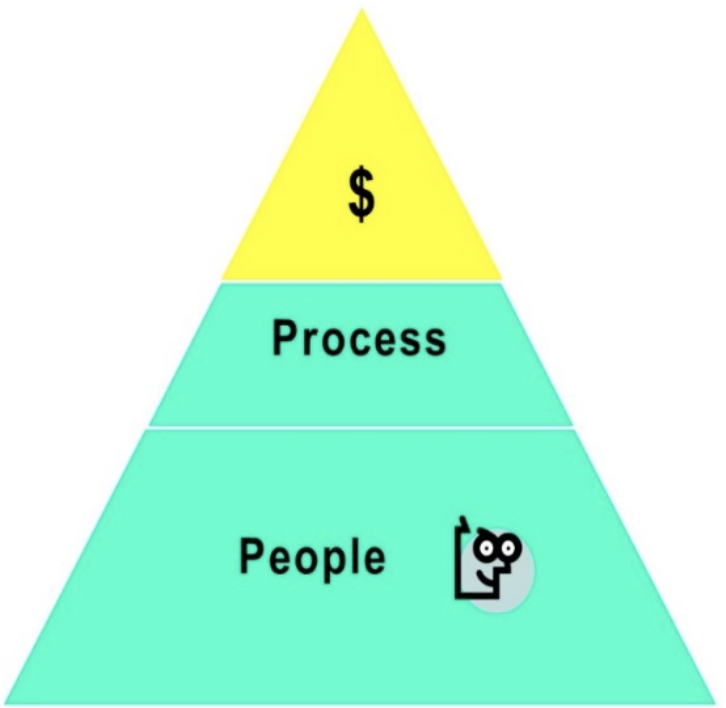
The 3 ‘P’s of High Achievement Companies: People, Process, Profit
In order to be a High Achievement Company, you must be strong with People, Process and Profit. Being strong with just one or two of these is NOT enough to sustain success, achievement, and growth.
People

The first ‘P’ and the most foundational is People. There is simply no substitute for having the right people. Countless books, including but not limited to “Good to Great,” “Five Dysfunctions of a Team,” “In Search of Excellence” have identified the importance of having the right people. From our perspective the right people are individuals who can do the job, will do the job and fit our culture. All three must be present to ensure you have the right people.
Let’s walk through these one at a time:
Can Do
‘Can Do’ assesses whether the person has the abilities to adequately perform the baseline requirements of the job, regardless if the abilities are physical, emotional or mental. Individuals who cannot perform the baseline requirements are instantly disqualified. The first step in determining if a person ‘Can Do’ the baseline requirements of a job is preparing a job or position description that identifies the accountabilities and success metrics. High Achievement companies then use interviews and assessments to determine if an individual ‘Can Do’ the requisite duties.
There is simply no substitute for having the right people.
Will Do
Often an individual can perform the baseline requirements of the position or job but they chose not to. This is where ‘Will Do’ comes into play. ‘Will Do’ is essentially attitude, self-discipline, and self-motivation. High Achievement companies only want team members who desire to be there and will bring their best every day. High Achievement companies remove the people that ‘Can Do’ but ‘Will Not Do.”
Fit
‘Fit’ refers to the alignment between a team member and the organization’s core values and culture. A great example of ‘Fit’ is illustrated in one of my favorite books, “American Icon” by Bryce G. Hoffman. Hoffman chronicles the transformation of the leaders of Ford Motor Company into a team that is transparent, forthright, and collaborative. He also details how some members who were successful in the previous culture either could not, or would not make the change and since there was no longer a ‘Fit,’ a separation was in order.
One last note about People; Before you let go of team members that are in non-management positions because of ‘Will Do’ or ‘Fit,’ first make sure your leadership house is clean. A natural law of business is “The way the leadership team goes is the way the company goes.” The non-management team member may seem like the issue, but their performance and behavior may simply be a reflection of their supervisor. In other words, more often than not, performance issues with non-management team members are a symptom of another and larger issue: the wrong people in management positions.
The bottom line is start with your leaders. Make sure that the members of your company’s leadership team ‘Can Do’ the baseline requirements of their position, that they ‘Will Do’ the baseline requirements, and that they ‘Fit’ the culture you want in your company.
Having the right people is also a significant contributor to achieving the 3rd ‘P,’ Profit, because the right people, people who can do the job, will do the job and fit the culture, eliminates unnecessary cost, serves your customers and drives teamwork.
Process

The second ‘P’ of the 3 ‘P’s’ is Process. High Achievement companies have clearly defined interdepartmental processes. Many companies believe they are strong with respect to process because they have clearly defined intradepartmental processes such as an order entry process or performance review process. Intradepartment processes are important and helpful but clean interdepartment processes are critical to success and growth. An interdepartmental process is a process that is executed across multiple departments. Think of interdepartmental processes as the company’s major business processes and intellectual capital. It is how the company serves customers profitably, with quality and on time.
Every company has major interdepartmental processes whether they are recognized or not. If you don’t know your company’s major interdepartmental processes you need to figure them out because they facilitate speed, consistency, cost and quality. Companies that have clearly defined and measurable interdepartmental business processes have a significant advantage over competitors that do NOT have well defined interdepartmental processes.
Companies that have clearly defined and measurable interdepartmental business processes have a significant advantage over competitors that do NOT have well defined interdepartmental processes.
Most companies have 5 to 6 major interdepartmental business processes. Two common interdepartmental processes are Order to Cash and Concept to Offering. Order to Cash is the process for completing a sale, building the product, delivering the product and collecting payment. Concept to Product is the process for identifying customer/market needs, performing the R&D to develop the new product/service, launching the new product/service into production, and rolling out the new product/service to sales. For High Achievement Companies, every step in the major interdepartmental business process is value added, timely and the handoffs or transfers between departments are seamless.
Process is often supported by technology which can serve as an accelerator of the existing process. But make no mistake, technology alone can never be a substitute for clear, well-defined interdepartmental business processes.
The bottom line is the right people with well-defined and clean interdepartmental processes is a significant contributor to driving the third ‘P,’ Profit.
Profit

The third ‘P’ of the 3 ‘P’s’ is Profit. In spite of political gaming, profit is not a bad thing. As a matter of fact, long term sustained profit is recognition by your customers that you are doing things right. For-profit businesses are the greatest creator of value the world has known. For-profit businesses have elevated more people from lower class to middle class and middle class to upper class than any other institution. No government program has provided more value to society than for-profit businesses. Profit provides possibilities for its employees and investors.
Although making a profit is a good thing, it is not the only thing. In the words of Henry Ford, “A business that makes nothing but money is a poor business.” For High Achievement Companies the ultimate accomplishment is to simultaneously prosper their investors, their customers and their employees. All High Achievement companies are profitable companies but not all profitable companies are High Achievement companies. The difference between a high achievement profitable company and simply a profitable company is how the profit was derived. Was the profit derived through excessive cost cutting and short term thinking or was the profit derived through prudent investments, growth and continuous improvement. High achievement companies compete against themselves, not the competition. High Achievement Companies consistently challenge themselves to reduce costs and increase the value they provide to their customers. They invest and reinvest in facilitates, equipment and people for the purposes of driving productivity and retaining the best people.
High Achievement Companies success metrics are those 5-6 metrics that cover 90% of the business and define winning and losing from the perspective of: Investors/Owners, Employees, Customers, Industry.
High Achievement companies define success for themselves. They do not allow outside influences such as Wall Street or competitors to define their success and ultimately it is those success metrics that define whether they are profitable. High Achievement Companies success metrics are those 5-6 metrics that cover 90% of the business and define winning and losing from the perspective of: Investors/Owners, Employees, Customers, Industry. Building on the words of Henry Ford, in order to be truly profitable, you must be focused on more than just the bottom line. You must successfully meet or exceed all of the success metrics simultaneously. This definition or view of profitability maybe different, but in our experience, it is the ultimate measure of a company’s long-term profitability and sustained success.
So that’s it. Staff your company with the right people that can-do, will-do and fit your culture. Optimize your interdepartment processes; and define and achieve your profitability success metrics. I would love to hear your thinking on this. Reach out to me at Kathie.Mcbroom@thinking-organization.com
